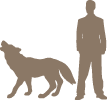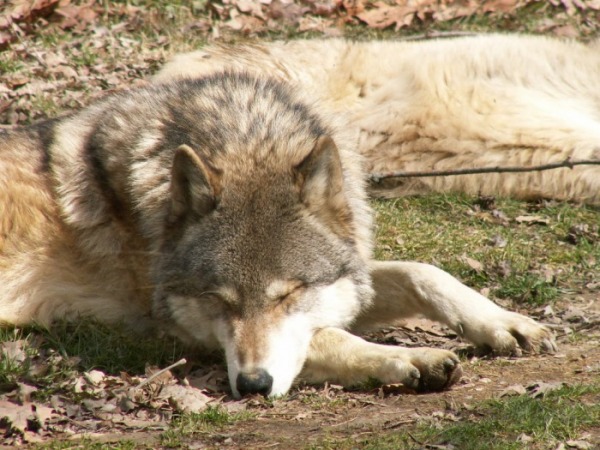Wolves (Canis Lupus):
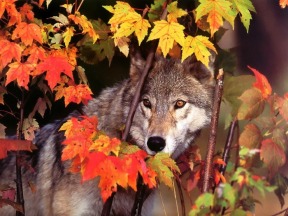
Wolves, are related to dogs, or more rightly, dogs are actually related to wolves.
Wolves and dogs are quite similar in many ways, however, in most cases, wolves are larger animals. Wolves generally have longer legs than dogs. It is difficult to imagine, however, everything from a pug dog to a doberman comes from the wolf.
The Wolf has developed the capacity to survive in the most inhospitable of climates. The wolves in the high arctic endure several winter months of perpetual darkness. Even in February when sun returns to the north, temperatures of -40°C and bitter winds are common. Other wolves are at home in the desert and the dampness of a humid Gulf Coast swamp.
Wolves and dogs are quite similar in many ways, however, in most cases, wolves are larger animals. Wolves generally have longer legs than dogs. It is difficult to imagine, however, everything from a pug dog to a doberman comes from the wolf.
The Wolf has developed the capacity to survive in the most inhospitable of climates. The wolves in the high arctic endure several winter months of perpetual darkness. Even in February when sun returns to the north, temperatures of -40°C and bitter winds are common. Other wolves are at home in the desert and the dampness of a humid Gulf Coast swamp.
Scientific Classification of Wolves
Kingdom Animalia (all animals)
Phylum Chordata (animals with notochords)
Subphylum Vertebrata (animals with a skeleton of bone or cartilage)
Class Mammalia (mammals)
Subclass Eutheria (placental mammals)
Order Carnivora (carnivores)
Family Canidae (dog family)
Genus Canis (dogs)
Species lupus (gray wolves) rufus (red wolves)
simensis (Abyssinian or Ethiopian wolf, which some
scientists think is a jackal)
Phylum Chordata (animals with notochords)
Subphylum Vertebrata (animals with a skeleton of bone or cartilage)
Class Mammalia (mammals)
Subclass Eutheria (placental mammals)
Order Carnivora (carnivores)
Family Canidae (dog family)
Genus Canis (dogs)
Species lupus (gray wolves) rufus (red wolves)
simensis (Abyssinian or Ethiopian wolf, which some
scientists think is a jackal)
General characteristic
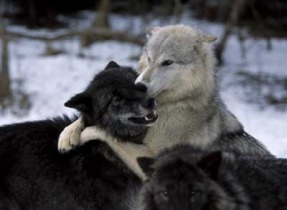
Wolves are very intelligent creatures whose upright ears, sharp teeth, pointed muzzles, inquiring eyes and other facial features instantly convey this quality.
The weight and size of a wolf can vary greatly worldwide. In general, height varies from 0.6 to .95 metres (26 - 38 inches) at the shoulder and weight ranges from 20 to 62 kilograms. The Grey Wolf is the largest of all wild canids. Extreme specimens of wolf weighing more than 77 kilograms (170 pounds) have been recorded in Alaska and Canada, although they are rarely encountered. The heaviest wild wolf on record, killed in Alaska in 1939, was 80 kilograms (175 pounds). The smallest wolves come from the Arabian Wolf subspecies, the females of which may weigh as little as 10 kilograms (22 pounds) at maturity. Females in any given wolf population typically weigh about 20% less than their male counterparts. Wolves can measure anywhere from 1.3 to 2 metres (4.5 - 6.5 feet) from nose to the tip of the tail, which itself accounts for approximately one quarter of overall body length.
Wolves bodies are built for stamina, possessing features ideal for long distance travel. Their narrow chests and powerful backs and legs assist their efficient locomotion. Wolves are capable of covering several miles trotting at about a pace of 10 kilometres per hour (6 miles per hour) and have been known to reach speeds approaching 65 kilometres per hour (40 miles per hour) during a chase. While sprinting, wolves can cover up to 5 metres (16 feet) per run.
The weight and size of a wolf can vary greatly worldwide. In general, height varies from 0.6 to .95 metres (26 - 38 inches) at the shoulder and weight ranges from 20 to 62 kilograms. The Grey Wolf is the largest of all wild canids. Extreme specimens of wolf weighing more than 77 kilograms (170 pounds) have been recorded in Alaska and Canada, although they are rarely encountered. The heaviest wild wolf on record, killed in Alaska in 1939, was 80 kilograms (175 pounds). The smallest wolves come from the Arabian Wolf subspecies, the females of which may weigh as little as 10 kilograms (22 pounds) at maturity. Females in any given wolf population typically weigh about 20% less than their male counterparts. Wolves can measure anywhere from 1.3 to 2 metres (4.5 - 6.5 feet) from nose to the tip of the tail, which itself accounts for approximately one quarter of overall body length.
Wolves bodies are built for stamina, possessing features ideal for long distance travel. Their narrow chests and powerful backs and legs assist their efficient locomotion. Wolves are capable of covering several miles trotting at about a pace of 10 kilometres per hour (6 miles per hour) and have been known to reach speeds approaching 65 kilometres per hour (40 miles per hour) during a chase. While sprinting, wolves can cover up to 5 metres (16 feet) per run.
Wolves and Humans
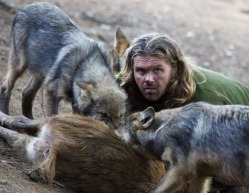
A wolf is afraid of humans in its whole life. However a wolf will accept humans if we take the pups away from their mother before they open their eyes or before they are 10 days old and we raise them among man - feeding them with nursing-bottle. If we take the pups away from their mother in time and we care for and deal with them a lot we might be able to practice them to lead and/or to muzzle. It can be suppled - but only partly.
Wolf Behaviour
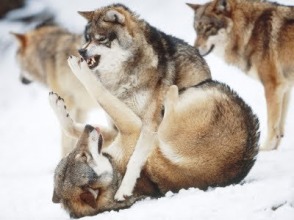
Wolves have many ways in which they behave and communicate with each other.They have a variety of expressions and moods that can be defined by subtle body movements like a shift in body weight to more obvious ones such as rolling on their backs on the floor in a submissive position.
Dominant Wolf - A dominant wolf stands stiff legged and tall. Their ears are erect and forward and the hackles bristle slightly. Often the tail is held vertical and curled toward the back. This display shows the wolfs rank to all others in the pack. A dominant wolf may stare penetratingly at a submissive one, pin it to the ground, 'ride up' on its shoulders, or even stand on its hind legs.
Angry Wolf - An angry wolfs ears are erect and its fur bristles. Their lips may curl up or pull back and the incisors are displayed. The wolf may also snarl.
Aggressive Wolf - A aggressive wolf may snarl and crouch backwards ready to pounce. Hairs will also stand erect on its back.
Fearful Wolf - A frightened wolf will try to make its body look small and therefore less conspicuous. Their ears flatten down against the head and the tail may be tucked between the legs, as with a submissive wolf. There may also be whimpering or barks of fear and the wolf may arch its back.
Defensive Wolf - A defensive wolf lays its ears back flat against its head.
Suspicious Wolf - A suspicious wolf will narrow its eyes and pull back its ears. Its tail will be pointed straight outwards parallel to the ground if it suspects danger.
Relaxed Wolf - The tail of a relaxed wolf will hang down relaxed or it may wag. The more its tail hangs down, the more relaxed the wolf is. The wolf may also sit like a sphinx or roll on its side.
Happy Wolf - A happy wolf will wag its tail just like a dog and will have its tongue lolled out.
Playful Wolf - A playful wolf holds its tail high and wags it. The wolf may frolic and dance around, or bow by placing the front of its body down to the ground, while holding their rear high, sometimes wagged. This is reminiscent of the playful behaviour displayed in domestic dogs.
Hunting Wolf - A hunting wolf will be tense and have its tail pointing straight out.
Submissive Wolf (Active) - In active submission, the entire body is lowered and the lips and ears are drawn back. Sometimes active submission is accompanied by muzzle licking, or the rapid thrusting out of the tongue and lowering of the hindquarters. Their tail is placed down, or halfway or fully between the legs and the muzzle often points up to the more dominant animal. Their back may be partially arched as the submissive wolf humbles itself to its superior. (A more arched back and more tucked tail indicate a greater level of submission.)
Submissive Wolf (Passive) - Passive submission is more intense than active submission. The wolf rolls on its back and exposes its vulnerable throat and underside. Their paws are drawn into the body. This is often accompanied by whimpering.
Information from:
www.animalcorner.net
Dominant Wolf - A dominant wolf stands stiff legged and tall. Their ears are erect and forward and the hackles bristle slightly. Often the tail is held vertical and curled toward the back. This display shows the wolfs rank to all others in the pack. A dominant wolf may stare penetratingly at a submissive one, pin it to the ground, 'ride up' on its shoulders, or even stand on its hind legs.
Angry Wolf - An angry wolfs ears are erect and its fur bristles. Their lips may curl up or pull back and the incisors are displayed. The wolf may also snarl.
Aggressive Wolf - A aggressive wolf may snarl and crouch backwards ready to pounce. Hairs will also stand erect on its back.
Fearful Wolf - A frightened wolf will try to make its body look small and therefore less conspicuous. Their ears flatten down against the head and the tail may be tucked between the legs, as with a submissive wolf. There may also be whimpering or barks of fear and the wolf may arch its back.
Defensive Wolf - A defensive wolf lays its ears back flat against its head.
Suspicious Wolf - A suspicious wolf will narrow its eyes and pull back its ears. Its tail will be pointed straight outwards parallel to the ground if it suspects danger.
Relaxed Wolf - The tail of a relaxed wolf will hang down relaxed or it may wag. The more its tail hangs down, the more relaxed the wolf is. The wolf may also sit like a sphinx or roll on its side.
Happy Wolf - A happy wolf will wag its tail just like a dog and will have its tongue lolled out.
Playful Wolf - A playful wolf holds its tail high and wags it. The wolf may frolic and dance around, or bow by placing the front of its body down to the ground, while holding their rear high, sometimes wagged. This is reminiscent of the playful behaviour displayed in domestic dogs.
Hunting Wolf - A hunting wolf will be tense and have its tail pointing straight out.
Submissive Wolf (Active) - In active submission, the entire body is lowered and the lips and ears are drawn back. Sometimes active submission is accompanied by muzzle licking, or the rapid thrusting out of the tongue and lowering of the hindquarters. Their tail is placed down, or halfway or fully between the legs and the muzzle often points up to the more dominant animal. Their back may be partially arched as the submissive wolf humbles itself to its superior. (A more arched back and more tucked tail indicate a greater level of submission.)
Submissive Wolf (Passive) - Passive submission is more intense than active submission. The wolf rolls on its back and exposes its vulnerable throat and underside. Their paws are drawn into the body. This is often accompanied by whimpering.
Information from:
www.animalcorner.net
Ancient Wolves
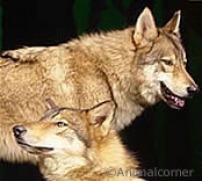
Humans and wolves met for the first time around 100,000 - 150,000 BC when us humans started to make way from Africa to Eurasia. When we arrived to Eurasia there were enough food for us and the wolves as well so we didn't really deal with them - nor did they. However when a younger wolf which was forced to leave its pack - or simply its just fallen behind - it got pretty close to the humans. These wolves ate the rubbish that the humans made and with this they prevented the illnesses from spreading. Later on the mentioned wolves became the partners of the humans and they became tame wolves. Their agression dropped, their ability to tolerate the stess began to grow and these tame wolves steped on the long way of becoming a dog.
Wolf Social Structure
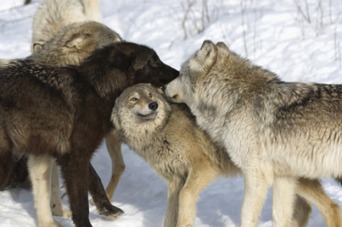
Wolves are gregarious animals who mostly live in packs. A pack is made when a male and a female wolf meet each other and stay together. As a mated pair, they find a territory to settle in and raise cubs most years. Their cubs stay with them until they are old enough to leave home, usually by the time they are 3 years old and conditions are right to start a family or pack of their own.
The hierarchy in a wolf pack is led by the alpha male and female. This affects all activity in the pack to some extent. In most larger packs, there are two separate hierarchies in addition to an overbearing one. The first consists of the males, led by the alpha male and the other consists of the females, led by the alpha female. In this situation, the alpha male assumes the top position overall in the pack. However, in some cases during the mating season the alpha female takes total dominance even while the pups are still in the den. This is for the rest of the pack to know that she is the one to serve. She also decides were the den will be. With this in the packs mind, they go in search of food and bring it back to the den either for the hungry female or for the pups.
The male and female hierarchies are interdependent and are maintained constantly by aggressive and elaborate displays of dominance and submission. Control of breeding rights is one of the key privileges held by alpha wolves. Alphas are usually the only wolves in the pack to breed and they actively and sometimes aggressively prevent other adult wolves in the pack from breeding. If the other adults want to breed they usually have to leave their pack and set up elsewhere.
Another privilege for the alpha pair is access to food. When a large prey has been captured, they have first rights to eat as much as they want, along with their offspring (pups). In times when food is scarce, the other adults in the pack may do better to disperse and fend for themselves. However, wolves tend to feed amicably when food is ample.
In large packs of wolves there is sometimes a 'second in command'. These are known as the 'Beta wolf or wolves'. Beta wolves typically take on the role of raising the alpha pairs offspring, often becoming surrogate mothers or fathers to the pups while the alpha pair are absent. Beta wolves are the most likely to challenge their superiors for the role of the alpha, though some betas seem content with being second and will sometimes even let lower ranking wolves push ahead of them for the position of alpha should circumstances make it necessary for this to happen (death of the alpha, etc.) More ambitious betas, however, cannot wait for the top spot and will challenge the alpha sooner or disperse from the pack to create one of its own. Sometimes, if the alpha is an aging wolf, he will give up his position submissively and allow the beta to take his place. Healthier alphas will fight his challenger intensely to keep his lead roll, sometimes resulting in each one being injured. The loser is usually chased away or may be killed as other aggressive wolves contribute to the opposition. This kind of dominance encounter is more common during the mating season.
Wolf rank order within a pack is established and maintained through a series of 'ritualised fights' and posturing best described as 'ritual bluffing'. Wolves prefer psychological warfare to physical confrontations, meaning that high-ranking status is based more on personality or attitude than on size or physical strength. Rank, who holds it, and how it is enforced varies widely between packs and between individual animals. In large packs full of easygoing wolves, or in a group of juvenile wolves, rank order may shift almost constantly.
information from: www.animalcorner.net
The hierarchy in a wolf pack is led by the alpha male and female. This affects all activity in the pack to some extent. In most larger packs, there are two separate hierarchies in addition to an overbearing one. The first consists of the males, led by the alpha male and the other consists of the females, led by the alpha female. In this situation, the alpha male assumes the top position overall in the pack. However, in some cases during the mating season the alpha female takes total dominance even while the pups are still in the den. This is for the rest of the pack to know that she is the one to serve. She also decides were the den will be. With this in the packs mind, they go in search of food and bring it back to the den either for the hungry female or for the pups.
The male and female hierarchies are interdependent and are maintained constantly by aggressive and elaborate displays of dominance and submission. Control of breeding rights is one of the key privileges held by alpha wolves. Alphas are usually the only wolves in the pack to breed and they actively and sometimes aggressively prevent other adult wolves in the pack from breeding. If the other adults want to breed they usually have to leave their pack and set up elsewhere.
Another privilege for the alpha pair is access to food. When a large prey has been captured, they have first rights to eat as much as they want, along with their offspring (pups). In times when food is scarce, the other adults in the pack may do better to disperse and fend for themselves. However, wolves tend to feed amicably when food is ample.
In large packs of wolves there is sometimes a 'second in command'. These are known as the 'Beta wolf or wolves'. Beta wolves typically take on the role of raising the alpha pairs offspring, often becoming surrogate mothers or fathers to the pups while the alpha pair are absent. Beta wolves are the most likely to challenge their superiors for the role of the alpha, though some betas seem content with being second and will sometimes even let lower ranking wolves push ahead of them for the position of alpha should circumstances make it necessary for this to happen (death of the alpha, etc.) More ambitious betas, however, cannot wait for the top spot and will challenge the alpha sooner or disperse from the pack to create one of its own. Sometimes, if the alpha is an aging wolf, he will give up his position submissively and allow the beta to take his place. Healthier alphas will fight his challenger intensely to keep his lead roll, sometimes resulting in each one being injured. The loser is usually chased away or may be killed as other aggressive wolves contribute to the opposition. This kind of dominance encounter is more common during the mating season.
Wolf rank order within a pack is established and maintained through a series of 'ritualised fights' and posturing best described as 'ritual bluffing'. Wolves prefer psychological warfare to physical confrontations, meaning that high-ranking status is based more on personality or attitude than on size or physical strength. Rank, who holds it, and how it is enforced varies widely between packs and between individual animals. In large packs full of easygoing wolves, or in a group of juvenile wolves, rank order may shift almost constantly.
information from: www.animalcorner.net
